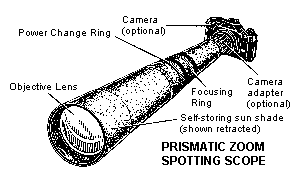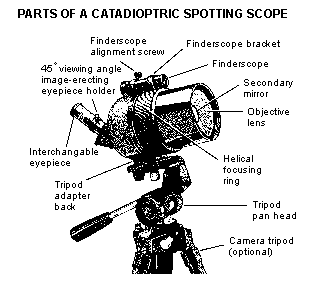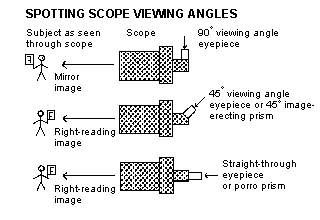Sometimes, a binocular can't get you close enough to a bird
to show you the detail you need. Beyond a hundred feet or so, subtle field marks
start becoming difficult to differentiate. You can tell it's a Sandpiper, but what
kind? A Western, a Semipalmated, a Baird's? They look very similar at long distances.
A spotting scope gets you closer to the subject so you
can tell what kind of Sandpiper it is, or whether that really is a deer lurking
at the far end of your property. A spotting scope's magnification starts where your
binocular leaves off.
Spotting scopes are compact telescopes designed primarily
for terrestrial observing and photography. In addition to birding, some other uses
include:
1.- viewing distant sports events, such as boat races
and mountain climbing;
2.- observing deer, mountain goats, and other easily-spooked
animal life;
3.- use as a long distance microscope for safe close-up
study of hornets' nests, bee hives, etc.;
4.- surveillance of property and outbuildings for the
isolated homeowner, rancher, or farmer;
5.- scanning ski resort, lake, or harbor activities
from the home with a view;
6.- casual astronomy; and more.
There are two types of spotting scopes available: prismatic
(a simple refractor, with a lens at one end and an eyepiece at the other) and catadioptric
(a combination of lenses and mirrors).
 An
An
eyepiece placed directly in the back of an ordinary telescope shows you an image
that's upside down and backwards. Because of this, prismatic spotting scopes come
with a built-in erecting prism system, such as the straight-through viewing porro
prism in the prismatic scope below. Others, such as the catadioptric scope shown
on the next page, come with a prism for observing at a 45° viewing angle (looking
down at a 45° angle to see straight ahead). Both give you erect and right-reading
images (correctly oriented from left to right) so you can read printing - distant
boat names and license plates, for example.
Many spotting scopes come with a zoom eyepiece offering
a range of magnifications. On some, you can replace the zoom eyepiece with other
eyepieces, each with a single fixed magnification. A zoom is more flexible
than a single power eyepiece, but generally has a narrower field of view and somewhat
lower resolution and contrast because of the extra lenses in the zoom mechanism.
Low power eyepieces, or low power settings on a zoom, usually
provide more satisfactory images than higher power eyepieces due to the wider fields
of view and brighter images at low powers.
With many prismatic spotting scopes, the eyepiece is in
a straight line with the main lens of the scope, such as in the scopes shown on
this page. Many American birders prefer this straight-through viewing arrangement.
It allows them to roughly center the scope on a distant bird by sighting over the
scope barrel (or using the non-magnifying peep sight or bead and notch sight most
scopes have as an aiming aid), before attempting to find the bird in the narrow
field of the eyepiece. It also allows viewing over hedge tops with a minimum of
the birder visible to disturb the birds. Straight-through viewing is also the most
convenient for photography.
Scopes with a 45° viewing angle are the most popular in
Europe, where observing is often done from a seated position in a "hide" or 
blind. A 45° viewing angle scope is the most comfortable type for tall observers
to use without getting a crick in their neck, for observing while seated, as well
as for examining tree tops. 45° viewing angle scopes are enjoying a rise in popularity
in this country due to these comfort factors.
A spotting scope should always be used on a tripod, as hand-holding
a high power scope is impractical. With straight-through scopes, a tall tripod is
needed so that a tall observer can observe without uncomfortable crouching. A 45°
viewing angle scope is handy when tall and short observers must share a spotting
scope, as it eliminates the need to constantly raise or lower the tripod to accommodate
their different eye levels.
Because of their limited magnification range, prismatic
and refractor spotting scopes are generally the most useful for medium power birding
at moderate distances from 150 feet or so, where binoculars start to leave off,
out to perhaps 500 yards. (These distances are not limits, merely suggestions.)
Catadioptric (combination lens/mirror) spotting scopes are
often powerful telephoto lenses equipped with an image-erecting prism system and
an eyepiece for visual use. They are usually the best choice as a high power spotting
scope if long distance nature photography is a major part of your birding plans.
 The
The
combination of lenses and mirrors in a catadioptric spotting scope folds a long
focal length into a short package, giving you high visual magnification and exceptional
telephoto lens performance without excessive bulk.
The large aperture and long focal length of a catadioptric
spotting scope make it very suitable for high power terrestrial views from a fixed
location - such as from a patio, vacation cabin, or beach house. Its long focal
length gives you a narrow field of view, however. This limits its usefulness for
those activities requiring a wide "picture-window" view, such as scanning scenery,
following fast-moving sports, close-in birding, etc. Catadiop-trics are generally
most useful for high power observing at moderate to long distances of between 200
feet and one mile. (Again, these distance are not limits, merely suggestions.)
Because of its narrow field, a catadioptric spotting scope
usually comes with a finderscope (a small low-power telescope, with crosshairs,
mounted on the side of the main scope and used to help you center the scope on distant
objects).
A few spotting scopes, most notably the catadioptric Questar
and some versions of the TeleVue Pronto and Ranger refractors, have a 90° viewing
angle eyepiece holder that positions the eyepiece at right angles to the line of
sight. You look down into the eyepiece to see birds in front of you. This gives
sharper images, but some people occasionally find the viewing position awkward.
Also, the 90° eyepiece holder shows mirror images (printing is upright, but backwards).
This means that a bird appearing to move left-to-right in the eyepiece requires
that you move the scope right-to-left to track it properly, which some observers
initially find confusing. It soon becomes second nature, however, just as it is
no problem to comb your hair by looking at your reversed image in a mirror.
 If
If
straight-through viewing would be more comfortable, however, or if right-reading
images are required for surveillance, reading the home ports of distant ships, etc.,
optional image erecting systems are available to give you both straight-through
viewing and correctly oriented images with these 90° scopes.
Most catadioptric scopes come with a removable 45° viewing
angle eyepiece holder for a viewing position intermediate between straight-through
viewing prismatic scopes and 90° viewing Questar catadioptrics. These 45° eyepiece
holders give correctly-oriented images (both erect and right-reading), without the
need to buy a separate porro prism to make the target motion you see in the scope
agree with what you see with your bare eyes. And the 45° viewing angle yields a
comfortable viewing position for long birding sessions, particularly for tall observers
with short tripods.
If you plan to use your automobile as a mobile blind, straight-through
viewing - or a 45° viewing system that can be tilted from side to side - is virtually
essential, as there's usually not enough room to fit your head between your car's
headliner and the eyepiece of a 90° viewing angle scope on a car window mount.
The magnification of any catadioptric spotting scope can
be changed by simply substituting a different eyepiece. Zoom eyepieces are available
and provide considerable observing flexibility, although at the cost of somewhat
lower contrast and a narrower field of view at low powers than single power eyepieces
of comparable magnifications.
Due to a catadioptric's folded optical path design, an image of its secondary mirror
is sometimes visible as a grey blur in the center of the field during daylight observing
at very low powers (lower than that provided by the eyepiece normally supplied with
the scope). This secondary mirror image can be eliminated by switching to a higher
power eyepiece.








